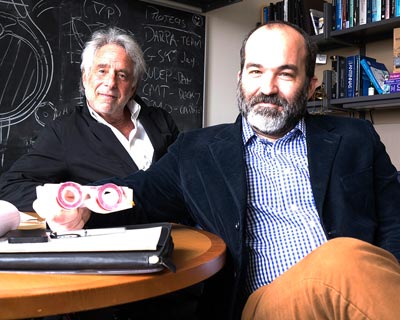Someday it may be possible to treat glaucoma by wearing a special pair of glasses outfitted with an electromagnetic coil. These glasses, developed by Bionode, are currently being tested. This device might be able to treat glaucoma without eyedrops, according to researcher Ike Ahmed, MD.
Dr. Ahmed, an ophthalmologist at the Prism Eye Institute in Toronto, is involved in studies of the new device and is a consultant to and a clinical investigator for Bionode.
In glaucoma, fluid builds up in the front part of the eye. The extra fluid leads to increased pressure in the eye and can damage the optic nerve. Without treatment, glaucoma can result in irreversible blindness. Treatment for glaucoma often involves eyedrops, which can cause side effects. And many older patients have trouble remembering when to put in their eyedrops. “We need a non-invasive, effective treatment for glaucoma that solves these issues,” Dr. Ahmed said.
The new glasses contain a metal coil that produces a magnetic field and generates a current. The current flows through the ciliary muscles—a ring of muscle within the middle layer of the eye—and electrically stimulates the area where fluid leaves the eye. The treatment allows the natural drainage pathway to work more efficiently. This decreases pressure in the eye.
The researchers also are testing the glasses paired with a contact lens that contains a trace of gold. The glasses transmit the electromagnetic current to the eye through the gold in the contact lens. Because older people are often uncomfortable wearing contact lenses, the researchers came up with glasses that could be used without contacts.

Bionode co-founders Pedro Irazoqui, PhD (left), and Murray I. Firestone, PhD, with a pair of prototype Bionode glasses.
The researchers hope to develop a device that will look like regular eyeglass frames. The treatment coil would be in the frame surrounding the lens.
“Like the new glasses, glaucoma drugs also work by stimulating muscle function in the eye,” Dr. Ahmed said. “Instead of using drops, we’re using low-voltage, safe electromagnetic current in the glasses that reach the eye.”
He said early studies, which are still ongoing, suggest the treatment seems to be safe. “Patients do not experience any pain or discomfort and we have not seen any side effects so far.”
Animal studies showed Bionode lowered intraocular eye pressure quickly—within 10 to 15 minutes. Human studies are starting in the United States, Canada and Spain. Michael Greenwood, MD, an ophthalmologist in Fargo, North Dakota, was optimistic about the possibilities of this device. “If clinical trials prove this treatment to be safe and effective, it could change the lives of many patients. The thought of having a non-surgical and a non-pharmaceutical method to lower IOP (intraocular pressure) is extremely exciting. There is still much to learn, but it would certainly help a lot of people.”
If the treatment is effective, it could prevent further loss of vision in patients with glaucoma. Dr. Ahmed hopes the treatment could be used in a wide variety of patients. People with early glaucoma who don’t want to put in eyedrops every day could benefit as much as those who already use medication and want to reduce the number of drops required. It may even be useful for patients with advanced glaucoma who have had surgical treatment.
“We are now studying many questions, including how long people need to wear the glasses, what dose of current is needed, and how long the effect of the glasses lasts, even after a person takes them off,” Dr. Ahmed said. “Over the course of the next year, we’ll start to see how effective the treatment is, and get a better idea of when it might become commercially available.”